List of active Japan Maritime Self-Defense Force ships
List of active ships of the Japan Maritime Self-Defense Force is a list of ships in active service with the Japan Maritime Self-Defense Force. The JMSDF is one of the world's largest navies and the second largest navy in Asia in terms of fleet tonnage.[1] As of 2022, the JMSDF operates a total of 155 vessels (including minor auxiliary vessels), including; four helicopter destroyers (or helicopter carriers), 36 destroyers, 10 small destroyers (or frigates), two frigates, six destroyer escorts (or corvettes), 22 attack submarines, 30 mine countermeasure vessels, six patrol vessels, three landing ship tanks, 8 training vessels and a fleet of various auxiliary ships.[2][3]

As of 2013, a procurement list added to the current National Defense Program Guidelines (NDPG) has revealed that, among other things, an additional 48 escort vessels of various classes are planned to be added to the MSDF fleet in the 2020s.[4] In addition, as of 7 July 2013, it was being reported that plans were under way to procure two more Aegis equipped destroyers in order to bolster ongoing BMD efforts, the first to be contracted for in fiscal year 2015 and the other in fiscal year 2016.[5]
Submarine fleet
Submarines
| Class | Picture | Type | Boats | Displacement | Note |
|---|---|---|---|---|---|
| Submarines (22 in Service) | |||||
| Taigei-class | _sailing_in_Port_of_Kobe_March_9%252C_2022_25.jpg.webp) |
Attack submarine | JS Taigei JS Hakugei |
3,000 tonnes (surfaced) | The first submarine of this class, Taigei, was commissioned on March 9, 2022.[6] JS Jingei launched but not completed, three additional boats not yet launched (October 2022). |
| Sōryū-class | .jpg.webp) |
JS Sōryū JS Unryū JS Hakuryū JS Kenryū JS Zuiryū JS Kokuryū JS Jinryū JS Sekiryū JS Seiryū JS Shōryū JS Ōryū JS Tōryū |
2,900 tonnes (surfaced) 4,200 tonnes (submerged) |
The JS Ōryū is the world's first submarine powered by lithium-ion batteries.[7] | |
| Oyashio-class | .jpg.webp) |
JS Uzushio JS Makishio JS Isoshio JS Narushio JS Kuroshio JS Takashio JS Yaeshio JS Setoshio JS Mochishio |
2,750 tonnes (surfaced) 4,000 tonnes (submerged) |
2 of 11 built converted to training ships (see Training Vessels below). | |
Surface fleet
Helicopter destroyers (de facto helicopter carrier/light aircraft carrier) - DDH/CVL
Officially classed as "helicopter destroyers", these vessels have a full-length flight deck helicopter carrier configuration
| Class | Picture | Type | Ships | Displacement | Note |
|---|---|---|---|---|---|
| Helicopter destroyers - DDH (de facto light aircraft carrier) (2 in Service) | |||||
| Izumo-class |  |
Helicopter destroyer | JS Izumo JS Kaga |
27,000 tonnes | Converting into light aircraft carrier configuration to carry F-35B V/STOL fighters from the mid-2020s.[8][9] |
| Class | Picture | Type | Ships | Displacement | Note |
|---|---|---|---|---|---|
| Helicopter destroyers - DDH (de facto helicopter carrier) (2 in Service) | |||||
| Hyūga-class | .jpg.webp) |
Helicopter destroyer | JS Hyūga JS Ise |
19,000 tonnes | |
Landing ships
| Class | Picture | Type | Ships | Displacement | Note |
|---|---|---|---|---|---|
| Landing ships - LST (3 in Service) | |||||
| Ōsumi-class |  |
Landing ship tank (de facto Amphibious transport dock) | JS Ōsumi JS Shimokita JS Kunisaki |
14,000 tonnes | Class modestly upgraded to land Boeing MV-22s and carry the AAV7A1 Amphibious Assault Vehicles.[10][11][12] |
| Landing craft - LCU (9 in Service) | |||||
| LCU-2001-class | 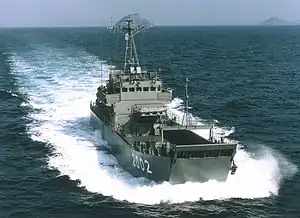 |
Utility landing craft | JS LC No.2 | 540 tonnes | |
| YL-09-class | 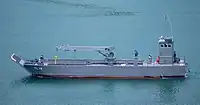 |
landing craft mechanized | JS YL-11 JS YL-12 JS YL-13 JS YL-14 JS YL-15 JS YL-16 JS YL-17 |
50 tonnes | |
| Landing craft - LCAC (6 in Service) | |||||
| 1-Go-class | _2104_returns_to_her_ship.jpg.webp) |
Landing Craft Air Cushion | 6 units in service | 182 tonnes | [13] |
Destroyers - DDG/DD
The JMSDF uses the official term Destroyers despite some larger ships being analogous to cruisers and smaller vessels being analogous to frigates by most international classifications.[14]
| Class | Picture | Type | Ships | Displacement | Note |
|---|---|---|---|---|---|
| Destroyers - DDG/DD (36 in Service) | |||||
| Maya-class | 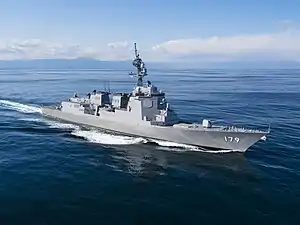 |
Guided missile destroyer (Aegis) | JS Maya JS Haguro |
10,500 tonnes | |
| Atago-class | 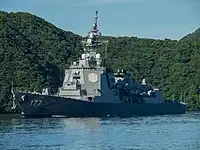 |
JS Atago JS Ashigara |
10,000 tonnes | ||
| Kongō-class | .jpg.webp) |
JS Kongō JS Kirishima JS Myōkō JS Chōkai |
9,500 tonnes | ||
| Asahi-class | 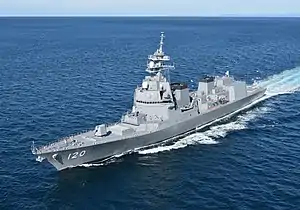 |
Destroyer | JS Asahi JS Shiranui |
6,800 tonnes | |
| Akizuki-class | 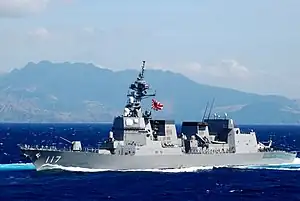 |
JS Akizuki JS Teruzuki JS Suzutsuki JS Fuyuzuki |
6,800 tonnes | ||
| Takanami-class | .jpg.webp) |
JS Takanami JS Onami JS Makinami JS Sazanami JS Suzunami |
6,400 tonnes | ||
| Murasame-class | .jpg.webp) |
JS Murasame JS Harusame JS Yūdachi JS Kirisame JS Inazuma JS Samidare JS Ikazuchi JS Akebono JS Ariake |
6,200 tonnes | ||
| Asagiri-class |  |
JS Asagiri JS Yamagiri JS Yūgiri JS Amagiri JS Hamagiri JS Setogiri JS Sawagiri JS Umigiri |
5,200 tonnes | ||
Frigate Multi-Purpose/Mine - FFM
| Class | Picture | Type | Ships | Displacement | Note |
|---|---|---|---|---|---|
| Frigate Multi-Purpose/Mine - FFM (4 in Service) | |||||
| Mogami-class | 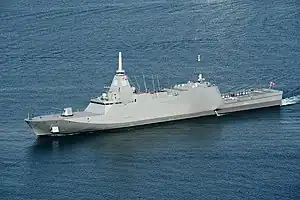 |
Frigate | JS Mogami JS Kumano JS Noshiro JS Mikuma |
5,500 tonnes | JS Yahagi, JS Agano, and JS Niyodo are launched, but still being fitted out. Originally, a total of 22 ships to this design are planned by 2032, but according to a new plan published by ATLA,[15] the Mogami class will be completed with 12 ships up to FY Reiwa 5 plan. The rest are to be continued with a new FFM design. |
Destroyer escorts - DE
| Class | Picture | Type | Ships | Displacement | Note |
|---|---|---|---|---|---|
| Destroyer escorts - DE (6 in Service) | |||||
| Abukuma-class | _(2).jpg.webp) |
Destroyer escort (or frigate) | JS Abukuma JS Jintsū JS Ōyodo JS Sendai JS Chikuma JS Tone |
2,550 tonnes | |
Mine countermeasure vessels
| Class | Picture | Type | Ships | Displacement | Note |
|---|---|---|---|---|---|
| Mine countermeasure vessels (22 in Service) | |||||
| Uraga-class | 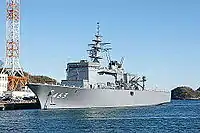 |
Minesweeper | JS Uraga JS Bungo |
6,850 tonnes | Categorized as "mine-countermeasures support ship". |
| Awaji-class |  |
JS Awaji JS Hirado JS Etajima |
690 tonnes | ||
| Enoshima-class | 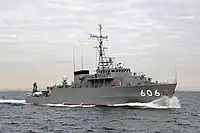 |
JS Enoshima JS Chichijima JS Hatsushima |
570 tonnes | ||
| Hirashima-class | 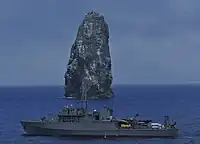 |
JS Hirashima JS Yakushima JS Takashima |
570 tonnes | ||
| Sugashima-class |  |
JS Sugashima JS Tsunoshima JS Naoshima JS Toyoshima JS Ukushima JS Izushima JS Aishima JS Aoshima JS Miyajima JS Shishijima JS Kuroshima |
570 tonnes | ||
Patrol vessels
| Class | Picture | Type | Ships | Displacement | Note |
|---|---|---|---|---|---|
| Patrol vessels (6 in Service) | |||||
| Hayabusa-class |  |
Patrol boat | JS Hayabusa JS Wakataka JS Otaka JS Kumataka JS Umitaka JS Shirataka |
240 tonnes | |
Training vessels
| Class | Picture | Type | Ships | Displacement | Note |
|---|---|---|---|---|---|
| Training vessels (7 in Service) | |||||
| Kashima-class |  |
Cadet training ship | JS Kashima | 4,050 tonnes | |
| Hatakaze-class | 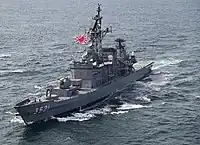 |
Training vessel | JS Hatakaze JS Shimakaze |
5,900 tonnes | Converted Hatakaze-class guided missile destroyer. |
| Oyashio-class |  |
Training submarine | JS Oyashio JS Michishio |
4,000 tonnes | Reconverted Oyashio-class submarines. |
| Kurobe-class | 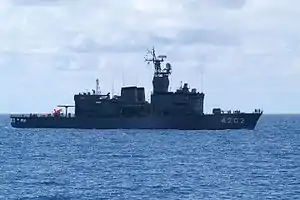 |
Training support ship | JS Kurobe | ||
| Tenryū-class | 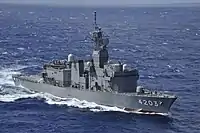 |
JS Tenryū | |||
Auxiliary fleet
Replenishment ships
| Class | Picture | Type | Ships | Displacement | Note |
|---|---|---|---|---|---|
| Replenishment ships (5 in Service) | |||||
| Mashū-class | 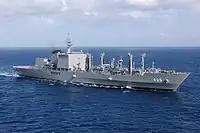 |
Replenishment oiler | JS Mashū JS Ōmi |
25,000 tonnes | |
| Towada-class | _pulls_away_from_the_guided-missile_destroyer_USS_Decatur_(DDG_73)_after_an_underway_replenishment_(UNREP).jpg.webp) |
JS Hamana JS Tokiwa JS Towada |
15,000 tonnes | ||
Miscellaneous
| Class | Picture | Type | Ships | Displacement | Note |
|---|---|---|---|---|---|
| Miscellaneous (17 in Service) | |||||
| Hiuchi-class | .jpg.webp) |
Training support ship | JS Hiuchi JS Suo JS Amakusa JS Genkai JS Enshu |
1,000 tonnes | |
-01.jpg.webp) |
Cable laying ship | JS Muroto | |||
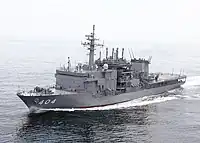 |
Submarine rescue vessel | JS Chiyoda | 5,600 tonnes (standard) | JMSDF commissions new submarine rescue ship[16] | |
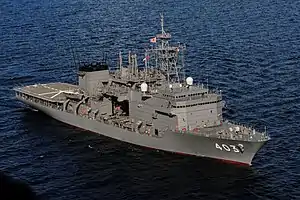 |
JS Chihaya | 6,900 tonnes | |||
| Futami-class | 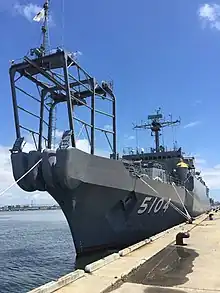 |
Oceanographic research ship | JS Wakasa | ||
.jpg.webp) |
JS Nichinan | ||||
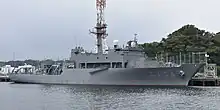 |
JS Shōnan | ||||
| Hibiki-class | _in_Kure_Naval_Base_20140915.JPG.webp) |
Ocean surveillance ship | JS Hibiki JS Harima JS Aki[17] |
||
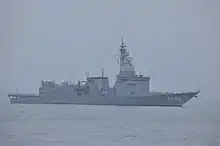 |
Experiment ship | JS Asuka | |||
_02.jpg.webp) |
Ice breaker | JS Shirase | 20,000 tonnes | ||
.jpg.webp) |
Yacht | JS Hashidate | |||
| YDT-01-class | 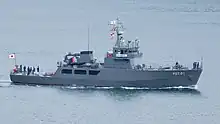 |
Diving support vessel | JS YDT-01 JS YDT-02 JS YDT-03 JS YDT-05 JS YDT-06 |
||
| YOT-01-class | 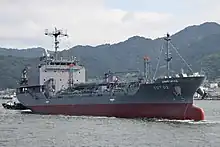 |
Yard oiler tanker | JS YOT-01 JS YOT-02 |
4,900 tonnes | |
Future JMSDF vessels

.jpg.webp)
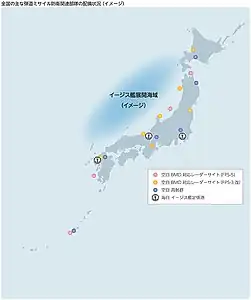

Authorized projects
Authorized projects for the Japanese Maritime Self-Defense Force include the ongoing construction of an improved AIP-type non-nuclear attack submarine class, the recapitalization of the JMSDF's frigate fleet units, and the acquisition of a pair of JMSDF-owned oil tankers and up to four amphibious tansports, as well as the pending construction of a dozen next-generation offshore patrol vessels (OPV) and two "Aegis system equipped ships" (ASEV) to provide dedicated sea-based ballistic missile defense (BMD) coverage of the Japanese home islands to replace the cancelled Aegis Ashore land-based BMD system.
29SS submarines
This submarine class has a non-nuclear air-independent propulsion (AIP) propulsion plant using improved lithium-ion batteries for enhanced silencing and operational flexibility. These submarines will also have improved sonar and weapons systems. The lead ship Taigei will serve as a test bed for the rest of the class, allowing more rapid technical upgrades to the other submarines within this class.[18][19]
30FFM frigates
In August 2017, the Acquisition, Technology & Logistics Agency (ATLA) selected Mitsubishi Heavy Industries (MHI) and Mitsui Engineering and Shipbuilding (MES) as the prime contractor and subcontractor to construct the frigate. In addition, the agency also selected a completely new design of the vessel (30DX). The new ship class is set to replace the Asagiri-class destroyers and Abukuma-class destroyer escorts.[20]
Amphibious transport vessels
At a press conference held on February 16, 2021, Defense Minister Nobuo Kishi announced that the Japan Self-Defense Force (JSDF) established a joint amphibious unit equipped with three new transport ships by 2024. These units will consist of one medium-sized Logistics Support Vessels (LSV) capable of carrying about 1,700 long tons (1,700 t) of cargo and three smaller Landing Craft Utility (LCUs) vessels with each capable of carrying 350 long tons (360 t) of cargo and operating in shallow waters. Although the Japan Maritime Self-Defense Force (JMSDF) has been basically responsible for the operation of the vessels, these vessels will be operated by a joint unit as the focus is on supporting the Japan Ground Self-Defense Force (JGSDF) and other forces operating in remote Southwest Islands, including Okinawa.[21] [22] The JSDF activated Japan's first marine unit since World War II on April 7, 2018, and the marines of the Amphibious Rapid Deployment Brigade (ARDB) are trained to counter invaders from occupying Japanese islands along the edge of the East China Sea.[23]
Next-generation offshore patrol vessels (OPV)
On 30 June 2022, the Japan Ministry of Defense (MOD) announced the construction of 12 offshore patrol vessels (OPV) (pictured) for the Japanese Maritime Self-Defense Force (JMSDF) at a cost of ¥ 9 billion ($66 million USD) per ship. Japan Marine United Corporation (JMU) is the prime contractor for this program with Mitsubishi Heavy Industries (MHI) chosen to be the subcontractor. Both JMU and MHI as well as Mitsui Engineering & Shipbuilding had submitted preliminary designs for the proposed next-generation OPVs.[24][25]
Aegis system equipped ships (ASEV)
In 2020, Japanese Defense Minister Nobuo Kishi announced plans to build 2 new Aegis destroyers (pictured) to replace its scrapped land-based Aegis Ashore ballistic missile interceptors program.[26] On August 31, 2022, the Japan Ministry of Defense announced that JMSDF will operate two "Aegis system equipped ships" (イージス・システム搭載艦 in Japanese) to replace its earlier cancellation of the Aegis Ashore program, commissioning one ship by the end of fiscal year 2027, and the other by the end of FY2028. The budget for design and other related expenses are to be submitted in the form of “item requests”, without specific amounts, and the initial procurement of the lead items are expected to clear legislation by FY2023. Construction is to begin in the following year of FY2024.[27][28][29][30]
Proposed projects

Given the various maritime-related territorial disputes and expanding operational requirements (pictured), the Japanese Maritime Self-Defense (JMSDF) has shown increased interest in augmenting its amphibious lift and expeditionary capabilities. Consequently, several Japanese defense firms such as Japan Marine United Corporation (JMU) and Mitsui Engineering & Shipbuilding (MES) have proposed amphibious warfare options at such industry trade shows as the Maritime Air Systems & Technologies (MAST) and Defence and Security Equipment International (DSEI) exhibits. Also, on March 4, 2014, Japan and the United States announced a bilateral research project on a LCS-style warship pursuant to the Mutual Defense Assistance Act.[31]
Amphibious assault ships (LHD)
In 2014, Japanese Defense Minister Itsunori Onodera expressed the intention of buying one amphibious assault ship (LHD) from the United States to provide more amphibious capabilities than the current Osumi class landing ships. The Wasp-class amphibious assault ship is most likely candidate for acquisition.[32]
JMU design concept
During the annual Defence and Security Equipment International (DSEI) tradeshow held 18–19 November 2019 in Chiba, Japan, the Japan Marine United Corporation (JMU) unveiled its proposed design for a big-deck multi-purpose LHD-type amphibious assault ship for the Japan Maritime Self-Defense Force. The vessel’s design features a floodable well deck for embarking two LCAC air-cushion landing craft plus 20 AAV7A1 amphibious assault vehicles. Its full-length flight deck boasts five marked landing spots for helicopters or MV-22B tiltrotors. Two below-deck hangars have space for five more rotorcraft. The vessel has a 500-person crew and an embarked unit of 500 marines. The JMU concept art displayed three RIM-116 Rolling Airframe Missile (RAM) SeaRAM launchers located before and aft of the ship's island superstructure, as well as a Mk 15 Phalanx 20mm-Vulcan cannon-armed Close-in Weapon System (CIWS) on the forward deck.[33][34][35]
The JMU's proposed LHD vessel's displacement is approximately 20,000 long tons (20,000 t) with an overall length of 720 ft (220 m), a beam of 124 ft (38 m), a draft of 26.25 ft (8.00 m), and a top speed of 24 knots (44 km/h; 28 mph).[34][35] Overall, the proposed JMSDF amphibious assault ship is substantially smaller than China's Type 075 vessels, South Korea's proposed LPH-II design, the U.S. Navy's Wasp-class amphibious assault ship, and Italian Navy's Trieste, and is more comparable to the Mistral-class amphibious assault ship of the French or the Egyptian navies.[34] A JMU representative told Jane's 360 that while the Japan Maritime Self-Defense Force did not have a current requirement for an LHD-type amphibious assault ship of any kind to join the JMSDF's Self Defense Fleet, the Japan Marine United Corporation still expected the JMSDF to eventually issue such a requirement in the near future, with the JMU design as an alternative to a foreign design.[34]
MES design concept
At the Maritime Air Systems & Technologies (MAST) 2017 naval defense exhibition held in Tokyo, Mitsui Engineering & Shipbuilding (MES) unveiled a new LHD-type amphibious assault ship for the Japan Maritime Self-Defense Force. MES drew on its experience from constructing and delivering the Osumi and Shimokita tank landing ships (LSTs) to the JMSDF when designing the new LHD. According to Mistui spokesmen, the main missions of the proposed LHD vessel is island defense as well as humanitarian assistance/disaster relief (HA/DR) operations, with the Japan Maritime Self-Defense Force (JMSDF) is reportedly looking to boost its amphibious capabilities in order to protect its Southern Islands.[36]
Mitsui's proposed LHD vessel is designed for large-scale transportation of Landing Craft Air Cushion (LCAC) hovercraft, main battle tanks (MBTs), vehicles, cargo, and equipment, with multi-mission features. Its flight deck LHD has five helicopter spots and a hangar large enough to large helicopters such as the CH-47 Chinook tandem rotor heavy-lift helicopters. Its well deck is large enough to accommodate two LCACs, and it can store at least 24 assault amphibious vehicles (AAVs) on two decks.[36]
The Mitsui LHD concept measures 210 m (689 ft 0 in) in length, 35 m (114 ft 10 in) in width, and draws 7 m (23 ft 0 in) with displacement of 16,000 long tons (16,000 t) and a speed of 22 kn (25 mph; 41 km/h). The maximum complement of the vessel is 200 people including embarked troops. Mitsui's LHD is fitted with a forward Phalanx CIWS gun mount and a SeaRAM launcher at the stern. There are two shafts and two rudders, plus two bow thrusters. There is a main elevator for helicopters aft and a smaller one for stores and equipment forward near the island superstructure. Overall, the Mitsui LHD concept to the French Navy's Mistral-class LHDs.[36]
Amphibious transport dock (LPD)
At the Maritime Air Systems & Technologies (MAST) 2017 naval defense exhibition held in Tokyo, Mitsui Engineering & Shipbuilding (MES) unveiled a new amphibious transport dock (LPD) concept. According to Mistui spokesmen, the main missions of the proposed LPD vessel is island defense as well as humanitarian assistance/disaster relief (HA/DR) operations, with the Japan Maritime Self-Defense Force (JMSDF) is reportedly looking to boost its amphibious capabilities in order to protect its Southern Islands.[37]
The proposed MES LPD design concept has an aft flight deck with two helicopter spots and a hangar large enough to receive two V-22 Osprey tilt-rotor aircraft and a small size VTOL unmanned aerial vehicle (UAV) similar in size to the MQ-8B Fire Scout. Beneath the flight deck is a well deck large enough to accommodate two Landing Craft Air Cushion (LCAC) hovercraft. Up to 40 AAV, MBT, and APC vehicles can be carried on two lower decks within the ship. The proposed ship measures 210 m (689 ft 0 in) in length, 30 m (98 ft 5 in) in width, and a draft of 7 m (23 ft 0 in) with a displacement of 16,000 long tons (16,000 t) and a speed of 22 kn (25 mph; 41 km/h). The maximum complement of the vessel is 200 people, including embarked troops. The LPD is fitted with a forward Phalanx CIWS gun mount and a SeaRAM launcher on top of the helicopter hangar. The vessel has two shafts and two rudders, as well as two bow thrusters, and also features two retractable fin stabilizers.[37]
Mobile landing platform (MLP)
At the Maritime Air Systems & Technologies (MAST) 2017 naval defense exhibition held in Tokyo, Mitsui Engineering & Shipbuilding (MES) unveiled its Mobile Landing Platform (MLP) concept designed for large scale transportation of Landing Craft Air Cushion (LCAC) hovercraft, main battle tanks (MBTs), vehicles, cargo, and other equipment, with multi-mission and modular features. In addition to its aviation operations and amphibious capabilities, this MLP can act as an offshore base. The Japan Maritime Self-Defense Force is reportedly looking to boost its amphibious capabilities in order to protect its Southern Islands.[38]
The MES's overall MLP design combines the aviation facilities of the U.S. Navy's Lewis B. Puller-class expeditionary mobile base ships with the extensive amphibious and expeditionary capabilities of the Montford Point-class expeditionary transfer dock vessels. There are four helicopter spots on the flight deck, but no helicopter hanger, with an elevator for stores and equipment next to spot #2. There is also a ramp allowing vehicles access between the two main decks. The MES mobile landing platform concept measures 240 m (787 ft 5 in) in length, 39 m (127 ft 11 in) in width, and a draft of 7 m (23 ft 0 in). The ship's displacement is 21,000 long tons (21,000 t), a speed of 15 kn (17 mph; 28 km/h), and a maximum complement of 240 people.[38]
33DD destroyers
The 33DD (also known as DDR or Destroyer Revolution) was a Japanese destroyer proposed for the Japan Maritime Self-Defense Force. The tentative name of the class, 33 DD, is derived from an estimate that it would be budgeted in the Japanese era of Heisei 33 (2021).[39][40]
High Speed Multi-hull Vessel Optimization (HSMVO)
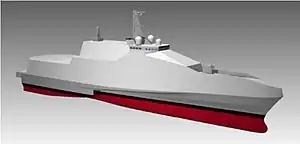
The joint HSMVO research is conducted by the Acquisition, Technology & Logistics Agency (ATLA) and the Naval Surface Warfare Center Carderock Division of the US Navy.[41][42] Also known as the Future Multi Purpose Trimaran concept, the HSMVO design concept is based on the Independence-class littoral combat ship with its distinctive trimaran hull design, modular mission capabilities, and aluminum construction (pictured). The mission capabilities of the concept includes mine countermeasure (MCM), humanitarian assistance and disaster recover (HADR), and offshore patrol/special ops. Likewise, each configuration will consist of different weapons, equipment, and supplies.[42]
ATLA unveiled the HSMVO trimaran warship concept model at the Japanese defense trade-show MAST Asia 2017. According to Navy Recognition website, the project is set to end in 2018 and the JMSDF would ultimately decide whether to adopt the concept for development or not.[42] To date, no decision has been made regarding the future acquisition and construction of warships based on the HSMVO design concept.
References
- IISS 2010, Japanese Maritime Self-Defense Force
- "Escort ship". Archived from the original on 23 December 2014. Retrieved 24 December 2014.
- "Submarine (vessels)". Archived from the original on 22 December 2014. Retrieved 24 December 2014.
- "EDITORIAL: Defense Ministry's 'shopping list' needs a radical review". AJW by The Asahi Shimbun. Archived from the original on 24 December 2014. Retrieved 24 December 2014.
- Japan eyes two new Aegis destroyers to counter N. Korea missile threat Archived 8 July 2013 at the Wayback Machine Japan Times, 7 July 2013
- 新型潜水艦「たいげい」就役 海自、22隻体制に増強 (in Japanese). The Chunichi Shimbun. 9 March 2022. Archived from the original on 9 March 2022. Retrieved 9 March 2022.
- Japan commissions first Sōryū-class submarine equipped with lithium-ion batteries Jane's, 05 March 2020
- "How Japan chose where to base its F-35s". 20 July 2021.
- "Japan is Investing Big in Its F-35 Stealth Fighter Fleet". 6 May 2021.
- "Japanese Shipbuilder Pitches Amphibious Assault Ship for Country's Growing Marine Forces". 21 November 2019.
- Adamczyk, Ed (11 May 2020). "Japan receives its first V-22 Osprey tiltrotor aircraft". United Press International. Archived from the original on 30 September 2022.
- "readdailynews.com". readdailynews.com. Archived from the original on 22 January 2014. Retrieved 6 September 2017.
- "Landing Craft, Air Cushion (LCAC)". GlobalSecurity.org. Retrieved 7 June 2023.
- John Pike. "Japanese Warships - Equipment Holdings". Archived from the original on 26 February 2015. Retrieved 24 December 2014.
- "「 新 型 F F M に 係 る 企 画 提 案 契 約 」 の 参 加 希 望 者 募 集 要 領" [Guidelines for recruiting applicants for the “Plan Proposal Contract Concerning the New FFM”] (PDF) (in Japanese). Acquisition, Technology and Logistics Agency. Retrieved 30 September 2023.
- "JMSDF commissions new submarine rescue ship". 20 March 2018. Archived from the original on 23 March 2018. Retrieved 23 March 2018.
- Dominguez, Gabriel (3 February 2020). "Japan launches third Hibiki-class ocean surveillance ship". Jane's Information Group.
- Takahashi, Kosuke (14 October 2020). "MHI launches first of new class of submarines for JMSDF equipped with lithium-ion batteries". Janes.com. Retrieved 19 September 2022.
- "防衛計画の大綱 中期防衛力整備計画" (PDF). Ministry of Defense (Japan). 2019. Retrieved 19 September 2022.
- "Mitsubishi Heavy Industries Unveiled 30FF or DEX Next Generation Vessel Concept for the JMSDF". Navy Recognition. 12 June 2015. Retrieved 26 October 2018.
- Yoshihiro Inaba (2 April 2021). "Japan To Introduce 3 New Transport Vessels By 2024". Naval News. Retrieved 30 September 2022.
- Yoshihiro Inaba (30 September 2021). "Japan's 2022 Defense Budget: An Overview Of The New Naval Programs". Naval News. Retrieved 30 September 2022.
- Kubo, Nobuhiro Japan activates first marines since WW2 to bolster defenses against China Archived 2018-08-02 at the Wayback Machine. April 7, 2018. Reuters. Retrieved August 2, 2018
- Kosuke Takahashi (2 July 2022). "Japan Awards Contract to Shipbuilder JMU for 12 New Offshore Patrol Vessels". The Diplomat. Retrieved 7 September 2022.
- Jr Ng (14 July 2022). "Japan Marine United selected to build JMSDF's next-gen OPV". Asia Military Review. Retrieved 7 September 2022.
- "Japan Defense Ministry plans new Aegis destroyers in place of Aegis Ashore". 24 November 2020. Archived from the original on 1 December 2020. Retrieved 29 December 2020.
- Lia Wong (1 September 2022). "Japanese Defense Budget Expansion Includes Two 20,000 Ton Cruisers". Overt Defense. Retrieved 7 September 2022.
- Dzirhan Mahadzir (6 September 2022). "Japan to Build Two 20,000-ton Missile Defense Warships, Indian Carrier Commissions". USNI News Blog. Retrieved 7 September 2022.
- Yoshihiro Inaba (1 September 2022). "Japan's New "Aegis Equipped Ships": What We Know So Far". NavalNews. Retrieved 7 September 2022.
- Kyle Mizokami (12 September 2022). "Japan Defense Ministry plans new Aegis destroyers in place of Aegis Ashore". Popular Mechanics. Archived from the original on 12 September 2022. Retrieved 13 September 2022.
- Fabey, Michael (8 March 2014). "U.S. To Help Japan Develop Littoral Warship". Aviation Week. Retrieved 31 January 2019.
- "Onodera sets out plans to buy amphibious assault ships". Archived from the original on 26 July 2014. Retrieved 24 December 2014.
- David Axe (5 February 2021). "Japan's Marines Could Be Due for a New Amphibious Assault Ship". The National Interest. Retrieved 7 September 2022.
- Joseph Trevithick (22 November 2019). "Japanese Shipbuilder Pitches Amphibious Assault Ship For Country's Growing Marine Forces". The Drive. Retrieved 7 September 2022.
- Baird Maritime (3 December 2019). "JMU Unveils First Images of Proposed Amphibious Assault Ship". Work Boat World. Retrieved 7 September 2022.
- "MAST Asia 2017: Mitsui Unveiled a New LHD Amphibious Assault Ship Concept". Navy Recognition. 12 June 2017. Retrieved 16 September 2022.
- "MAST Asia 2017: Mitsui Unveils New LPD Amphibious Transport Dock Concept". Navy Recognition. 12 June 2017. Retrieved 16 September 2022.
- "MAST Asia 2017: Mitsui Unveils Japanese MLP Concept". Navy Recognition. 12 June 2017. Retrieved 16 September 2022.
- "33DD Air Defense destroyer". Global Security. Retrieved 14 December 2018.
- "DDR Destroyer Revolution Next-generation DDG". Global Security. Retrieved 14 December 2018.
- Y. Miyauchi, S. Matsumoto, K. Suzuki, K. Harada (2015). "Research on Future Trimaran (US-JAPAN Co-operative Research)" (PDF). Japan Ministry of Defense. Retrieved 31 January 2019.
{{cite web}}: CS1 maint: multiple names: authors list (link) - "MAST Asia 2017: Japan's ATLA Unveils Future Multi Purpose Trimaran Concept". Navy Recognition. 13 June 2017. Retrieved 31 January 2019.
External links
- "Defense Programs and Budget of Japan FY Reiwa 5 (2023) Budget Overview" (PDF). Budget overview. Japanese Ministry of Defense. 23 December 2022. Retrieved 9 January 2023.
Japanese
- "Budget for Fundamental Strengthening of Defense Capabilities FY Reiwa 5 (2023) Budget Overview" (PDF). Budget overview. Japanese Ministry of Defense. 23 December 2022. Retrieved 9 January 2023.
Japanese
- Website on the Imperial Japanese Navy: JMSDF vessels